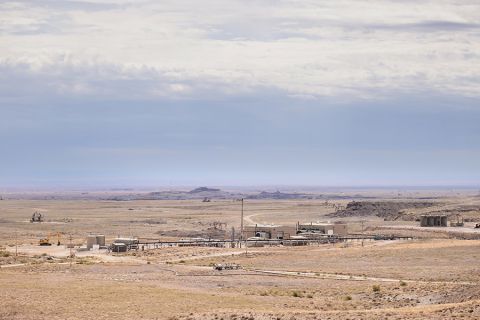
Institutions’ ownership of energy stocks gained 16 basis points to comprise 6.66% of all institutional investor ownership.
The rise could only be termed “modest,” but institutions’ ownership of energy stocks gained 16 basis points to comprise 6.66% of all institutional investor ownership, according to a third-quarter 2017 analysis from RBC Capital Markets. The positive turn came off the lowest point of ownership in a decade, registered in the previous quarter. The analysts looked at SEC form 13F filings from investors and managers and other smaller institutional holders.
Commodity prices prompted the uptick. Oil bested the $50/bbl critical point in September, driven by improving global oil demand, U.S. gasoline draws, the potential for slowing U.S. onshore oil production and leadership changes in the Saudi kingdom, according to the report. As year-end neared, however, investors remained selective.
“The competition for attention within energy continues to be fierce, but investors shifted more exposure into a slightly higher risk appetite, with refiners, majors/integrateds and E&P taking share at the expense of midstream and oilfield services,” the analysts said.
E&Ps now hold about a 29.2% share of the energy allocation—the first rise in more than a year and “not influenced by equity offerings,” according to the report. The aggregate quarterly increase in institutional market cap ownership was 9%.
Refiners and majors/integrateds rose by 90 and 30 basis points, respectively, representing 7.6% and 27.9%, the report found. Investors moved away from oilfield services, reducing allocation by 35 basis points to 13.8% of ownership in energy, continuing a general decline since mid-2014. Absorbing the greatest blow was midstream sector ownership, which was off 123 basis points to 20.8% but still near the peak, reached in mid-2015.
For the energy sector overall, institutional ownership by investment advisors and mutual funds fell just slightly; hedge funds held steady. In oilfield service, value and index investors replaced growth investors, according to the report, and E&Ps saw a relatively slight transfer from growth investors to yield. More growth investors moved into integrateds in place of index funds, as these energy companies benefited from higher commodity prices and strong refining margins.
The RBC report tracked ownership trends in E&P and offered strategies for positioning at year-end and into 2018. The second-quarter earnings season was “rough,” the analysts noted, casing doubt on Permian growth rates, but E&P stocks held strong for the most part. Canadian E&Ps boasted the greatest gains, with Canadian Natural Resources Ltd. (NYSE: CNQ) and Encana Corp. (NYSE: ECA) leading. Elsewhere, ConocoPhillips Co. (NYSE: COP) (9%) trailed only EOG Resources Inc. (NYSE: EOG), which is the top institutional investor holding at 10%; Occidental Petroleum Corp. (NYSE: OXY) followed at 8%.
Looking at basin strategies, the RBC report found that the Permian lost the most share at 88 basis points, but still is the institutional favorite at more than one-third of ownership. “The Permian’s downward move was the result of the gas-to-oil, operational and weather (hurricane) concerns that were prevalent in August and September,” the report noted. Pioneer Natural Resources Co. (NYSE: PXD) took the brunt, while Conchos Resources Inc. (NYSE: CXO) gained slightly, maybe as a result of Pioneer’s loss. “Natural gas stocks lost 38 basis points and stand at 10.6%.”
RBC’s favorite E&Ps are what it terms “quality beta” stocks that offer upside potential with lower business risk. Its focus names are Devon Energy Corp. (NYSE: DVN), Encana, RSP Permian Inc. (NYSE: RSPP), Callon Petroleum Co. (NYSE: CPE) and SRC Energy Inc. (NYSE: SRCI).
The thinking behind investor demand for 2018 keys off results of the late-November OPEC meeting outcome, but more largely on E&Ps’ 2018 capital budgets.
“Increased capital discipline is becoming more the rave, driven by investor demand for better shareholder and capital returns,” the RBC analysts said. “The most recent strategy is to look at growth as an output of capital allocation and not target specific growth rates. This probably works for larger companies, but maybe not small to mid-caps.” They look for 2018 budgets to post spending increases of 10% to 12%, “just slightly above the four-quarter 2017 run-rate.”
Hedging has been “robust,” with the RBC coverage group protecting nearly 60% of its 2018 oil production.
In oilfield services, E&P budget announcements will determine investor interest. Upward earnings revisions are needed “to catch the attention of generalists, in our view,” the analysts said. Their focus names are Halliburton Co. (NYSE: HAL) and Patterson-UTI Energy Inc. (NASDAQ: PTEN).
Midstream has been a laggard, but the RBC report noted that “midstreamers continue to charge ahead with new projects; it is telling in this market that they expect returns above even current costs of capital.” The analysts think Andeavor Logistics LP (NYSE: ANDX) and Tallgrass Energy Partners LP (NYSE: TEP), among others, “have the potential to react positively to new project announcements.”
Since the midstream’s access to public equity markets is “difficult” at present, funding issues remain a concern. “Midstreamers that need equity funding over the next 12 months are working on alternative financing. We expect funding gaps will increasingly fill through alternative equity such as preferreds, asset sales, joint ventures and ultimately a drive to utilize more retained cash,” the analysts said, with distribution taking a back seat, as they think it should.
Recommended Reading
Now, the Uinta: Drillers are Taking Utah’s Oily Stacked Pay Horizontal, at Last
2024-10-04 - Recently unconstrained by new rail capacity, operators are now putting laterals into the oily, western side of this long-producing basin that comes with little associated gas and little water, making it compete with the Permian Basin.
SM, Crescent Testing New Benches in Oily, Stacked Uinta Basin
2024-11-05 - The operators are landing laterals in zones in the estimated 17 stacked benches in addition to the traditional Uteland Butte.
Falcon, Tamboran Spud Second Well in Australia’s Beetaloo
2024-11-25 - Falcon Oil & Gas Ltd., with joint venture partner Tamboran, have spud a second well in the Shenandoah South Pilot Project in the Beetaloo.
Northern’s O’Grady: Most of ‘Best’ Acres ‘Already Been Bought’
2024-10-24 - Adding new-well inventory going forward will require “exploration or other creative measures,” said Nick O’Grady, whose Northern Oil and Gas holds interests in 10,000 Lower 48 wells.
E&P Highlights: Sept. 23, 2024
2024-09-23 - Here's a roundup of the latest E&P headlines, including Turkey receiving its first floating LNG platform and a partnership between SLB and Aramco.
Comments
Add new comment
This conversation is moderated according to Hart Energy community rules. Please read the rules before joining the discussion. If you’re experiencing any technical problems, please contact our customer care team.






